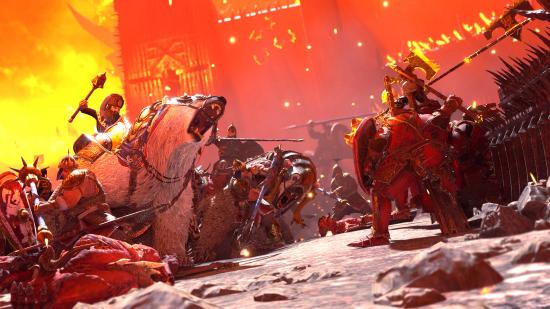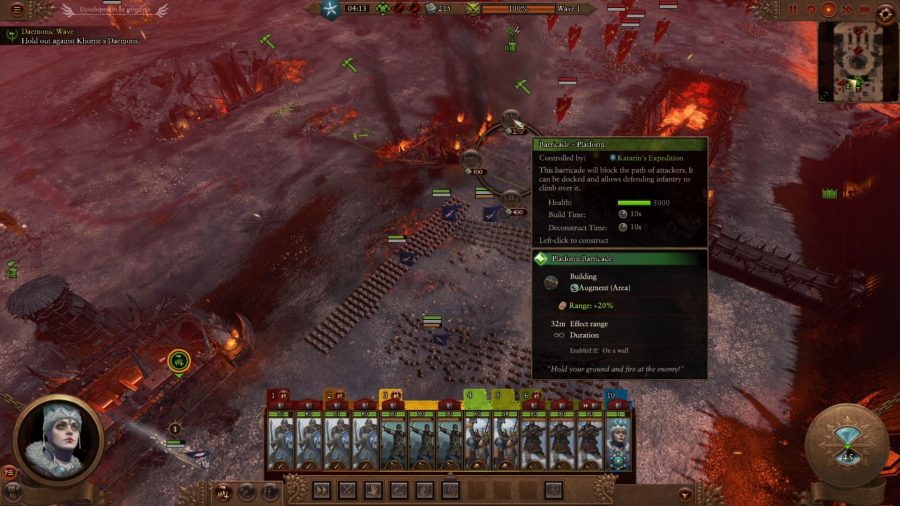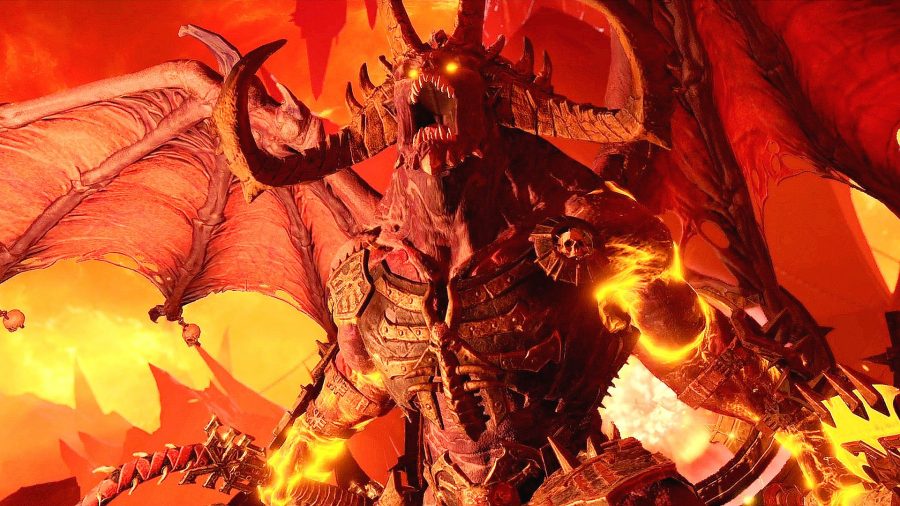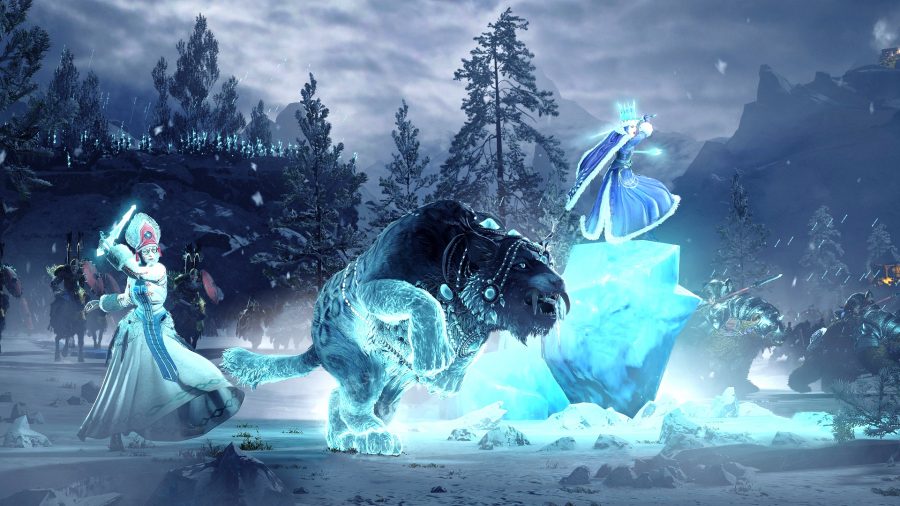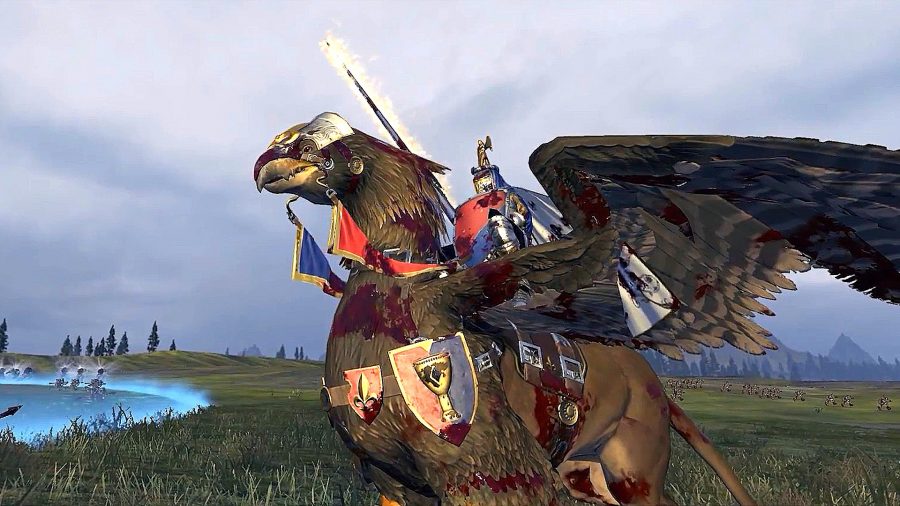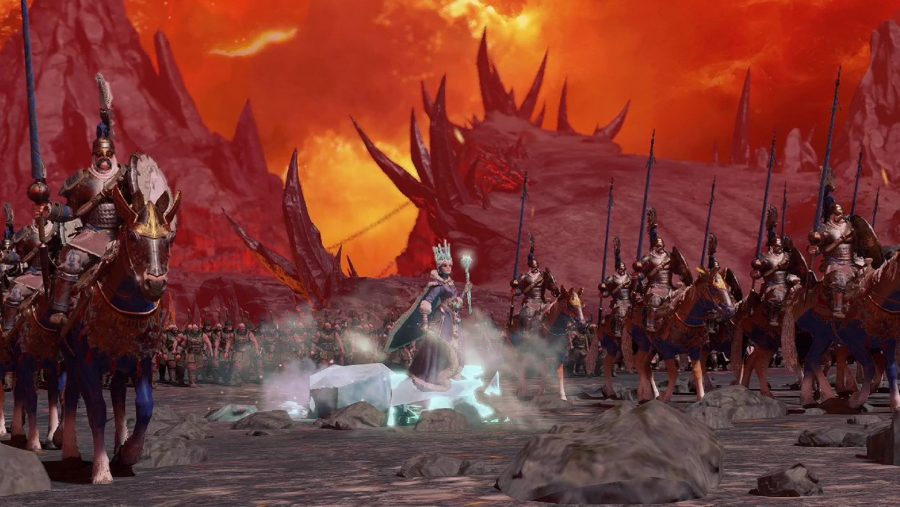Only a year and a half went by between Total War: Warhammers 1 and 2, but it’ll be roughly four years between 2 and 3 when the final release in the trilogy launches later this year.
The first game in the series broke new ground for developer Creative Assembly, and the second was another significant escalation, with the Total War studio offering its biggest map, most divergent faction design, and deepest storytelling yet, as well as its richest DLC support schedule. What, then, can we possibly expect from the trilogy’s conclusion, a game four years in the making, with Total War: Three Kingdoms having arrived in the interim and made its own, no less ambitious, contributions to the series?
We spoke with game director Ian Roxburgh and senior designer Oscar Andersson about the scale of CA’s ambition for the final game in the trilogy, and how its relationship with Warhammer publisher Games Workshop has evolved now that GW is working within this universe once again. Precedent, talk of doubling the map size, and our hands-on session with the epic new survival battles had already indicated that Warhammer III would be another leap in ambition. But the devs promise that much more is yet to come.
PCGamesN: Survival battles feel like an extension of the multi-wave battles at the end of the Vortex campaign in Warhammer II – was that your inspiration?
Ian Roxburgh: I guess so, but it’s also part of a bigger vision, which is to bring a lot of variety in new battle types and features across the campaign. We wanted to address all the things we could improve, that we would’ve wanted to do in previous games if we’d had the opportunity, as well as respond to what the fans were enjoying, and to bring loads of new things that people might not have expected.
Survival battles were fed by feedback on the kind of battles you just described – people really enjoyed them and felt they added to the game, creating these set piece moments that tie more closely into the narrative. We’ve explored that a lot more in Warhammer III, and the survival battles exemplify that. They also let us bring in some really interesting new dynamics and challenges to what is still essentially a Total War battle formula.

Tell us about those other battle types – I know the community has been eager to hear more about the siege rework, and you’re introducing minor settlement battles too.
IR: We can’t say more about siege battles, other than that we’ll discuss them in depth later on. We’ve added domination battles as a brand-new multiplayer battle type, which again we’ll discuss in a lot more detail in the future.
Oscar Andersson: Minor settlement battles are something the fans have been asking for, and Warhammer III gave us an opportunity to revisit them. They’ll contain some of the elements you’ve seen in the survival battle.
IR: They’re different to what the sieges will be, though they share some features. Some of their maps will be 360, some won’t, so it’s not just a few streets here and there. It’s a different style of gameplay altogether, creating an extra level of uniqueness and variety as you play through the campaign and are attacking minor settlements. Again, it’s something we wanted to do in the first few games, and we know the fans would like us to do them as well. The fans’ desires were very much in the forefront of our mind from the beginning of Warhammer III.
In tabletop the four Chaos gods are united in the Daemons of Chaos army, but they have such distinct identities. Presumably you’ve needed to create a huge number of new Daemon units to properly flesh them out and give them their own armies?
IR: What you’ve just said is so true, and it’s one of the reasons we were determined to separate the gods and not follow the army book formula to the letter. They’re all so unique in their own ways that we felt we needed to do them individually to do them justice, and there’s so much crazy stuff we can explore [as a result of that]. You know already if you play Warhammer that they’re very different, but when you play them in Total War you’ll see that we’ve exaggerated that. They’re as diverse from each other as a normal Chaos faction is to Empire.
Convinced: our historical Total War fan on the new survival battles
OA: We’ve done a lot of work figuring out which units can be added to the roster in terms of what’s supported by the IP and what suits the gameplay that we want each of the Chaos gods to have. We had to figure out what exactly a daemon is and what it does in Total War: Warhammer, and then we consider how the Khorne daemons play and feel, and then Nurgle, Tzeentch, and Slaanesh. It’s been a very exciting opportunity to push for very different strengths for each of them.
Will the Chaos factions be able to join in an Undivided form, as they did in tabletop?
IR: You’ll have to wait to have that question answered further down the line, I’m afraid! At the moment we’re just talking about the factions that we’ve announced so far, but keep your ears peeled for that one.
You’ve created units to flesh out armies before, but these factions must need so many more, and of course Games Workshop is working on Warhammer Fantasy again with the Old World. What’s changed about the process? And who came up with the Elemental Bear?
IR: That’s an example of some of the brand-new stuff that [Games] Workshop have been working on alongside us that you’ll have heard about already. We’ve done the same with Cathay, and they’ve just re-spruced up Kislev. It’s given us a brilliant opportunity to bring these new things into the game that fans won’t have seen before, and won’t have heard of in the army books, or even in the lore.
OA: From a lore perspective, the Elemental Bear is the power of the land incarnate. We got this amazing piece of concept art from Games Workshop with its lore, and we had a chance to work on this super-exciting unit. It’s something that you might not expect Kislev to have, but once you see it, it just makes perfect sense for them.
IR: It’s been an amazing experience working alongside Games Workshop as they’re going through their creative process while we’re going through ours at the same time. There’s a bit of to and fro, we can give feedback to each other. Ultimately it’s their IP, and we want to be faithful to what those folks come up with, but being in that loop early on has been really exciting for us.
When the first two games are received well, and they feel we’ve done a good service to their IP and that we really get it, that enables us to build the relationship to the point where there’s a lot of interaction over Kislev and Cathay, and a lot of mutual trust and respect. That means we can do things we never would’ve been able to do before, which adds value to the fans, particularly to those who’ve followed Warhammer outside of Total War.
For them to know that in Warhammer III there’s going to be a load of new stuff coming in, lore-wise, that they’ve never heard of before, it just adds that extra level of anticipation. It’s really exciting to know that there are fans out there who will love to see that new stuff, genuine new stuff, rather than just how we’ve interpreted what they already know. It’s added an extra spring in our step through the whole process of making Warhammer III.
Now that Games Workshop is working on Warhammer Fantasy with The Old World, and Warhammer III is due to launch later this year, it’s probable you’ll still be supporting it when The Old World releases. So what happens if GW updates an old army? Does its Total War faction get the new units?
IR: What I will say is that we do have an extensive plan, as we have had up to now with the first two games, to support Warhammer III after release through DLC and stuff. There’s a degree of flexibility there to be able to accommodate whatever Workshop are planning on doing, and we have our own plans in keeping with the vision we’ve had right from the beginning, which is, ultimately, to deliver everything in the IP.
That’s the philosophy behind the combined maps. Eventually, when we’ve made everything, we can put it all into one huge, huge map with everything in it. We’ve gone about doing that bit by bit. So yeah, I’m pretty sure if Workshop do stuff, we’ll accommodate that post-release. I can’t promise anything, and we don’t know exactly everything that’s going to happen, but we’ve got a very close working relationship with them. I’ll be surprised if you don’t see a good synergy between what you see from Workshop and what you see from us.
It feels like Warhammer I began a new era for Total War, and that the series has taken its biggest leaps with the Warhammer games. Has that been a function of the IP, or is it something CA internally has been looking to do for a long time?
IR: It was a philosophy right from the beginning, and it was helped very much by the IP: we really wanted to create the concept of asymmetry in a Total War game, and it’s easier to do that with races that are so diverse already through Warhammer lore than it would be in a historical context. That asymmetry in the first game was received so well universally – even by the hardcore fans – that it’s given us extra confidence to do more and more as we’ve gone along. We take it further each time, and we’ll continue to do that.
Curious? Get into the series with the best Total War games
Warhammer II was a big leap from Warhammer I. Is there anything you can share to quantify the scale of what we can expect in Warhammer III?
IR: Because of the success of the first few games, we’ve been able to plan something that’s just bigger, badder, better all around, right from the beginning. There’s loads of extra content, beyond anything we’ve ever done before. We’ve already announced more launch races [than the previous games], and loads of new features. We’re always ambitious – Warhammer II was a massive step up from Warhammer I, but Warhammer III is that times two. We want to go out with a massive bang.
